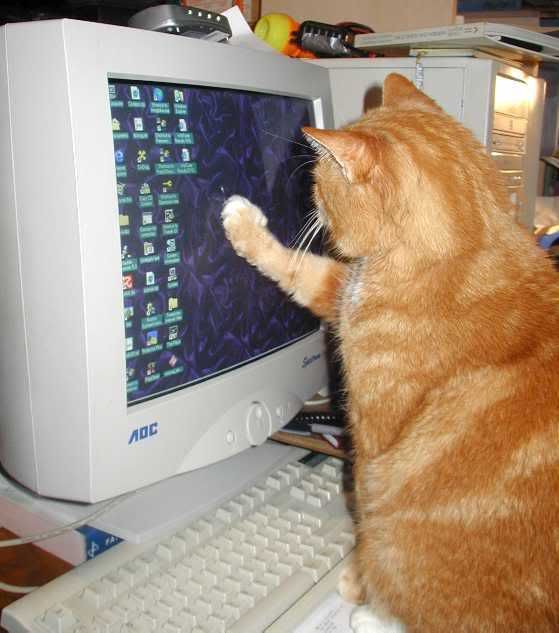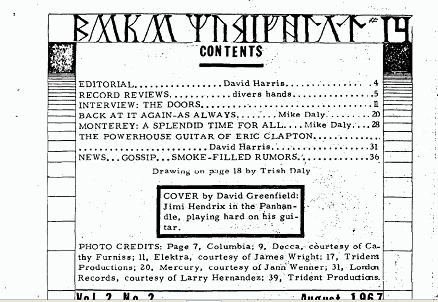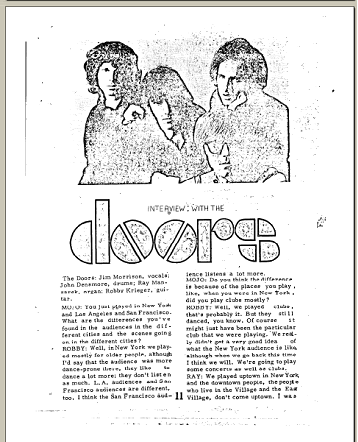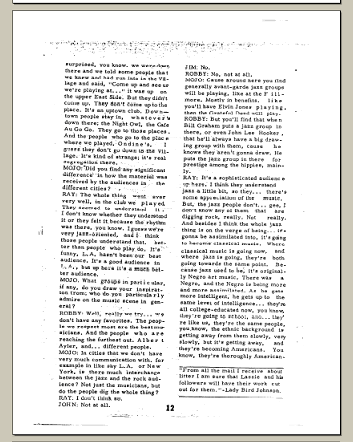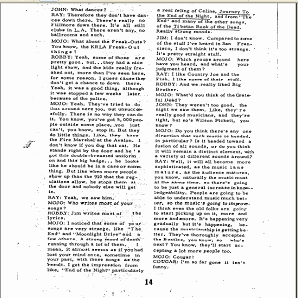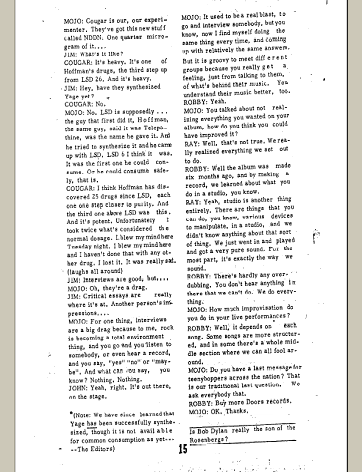Post by TheWallsScreamedPoetry on Feb 8, 2005 17:01:22 GMT
Greg Shaw Interview with the Doors

MOJO NAVIGATOR: You just played in New York and Los Angeles and San Francisco. What are the differences you've found in the audiences in the different cities and the scenes going on in the different cities?
ROBBY: Well, in New York we played mostly for older people, although I'd say that the audience was more dance-prone there, they like to dance a lot more; they don't listen as much. L.A. audiences and San Francisco audiences are different, too. I think the San Francisco audience listens a lot more.
MN: Do you think the difference is because of the places you play, like, when you were in New York did you play clubs mostly?
ROBBY: Well, we played clubs, that's probably it. But they still danced, you know. Of course it might just have been the particular club that we were playing. We really didn't get a very good idea of what the New York audience is like, although when we go back this time I think we will. We're going to play some concerts as well as clubs.
RAY: We played uptown in New York and the downtown people, the people who live in the Village and the East Village, don't come uptown. I was surprised, you know, we were down there and we told some people that we knew and had run into in the Village and said, "Come up and see us we're playing at.. ." it was up on the upper East Side. But they didn't come up. They don't come up to the place It' s an uptown club Downtown people stay in, whatever's down there; the Night Owl, the Café Au Go Go. They go to those places. And the people who go to the place where we played, Ondine's, I guess they don't go down to the Village It's kind of strange, it's real segregation there.
MN: Did you find any significant difference in how the material was received by the audiences in the different cities?
RAY: The whole thing went over very well in the club we played. They seemed to understand it. I don't know whether they understood it or they felt it because the rhythm was there, you know. I guess we're very jazz-oriented, and I think those people understand that, better than people who play do. It's funny, L.A. hasn't been our best audience. It's a good audience in L.A., but up here it's a much better audience.
MN: What groups in particular, if any, do you draw your inspirat-ion from; who, do you particularly admire on the music scene in general?
ROBBY: Well, really we try... we don't have any favorites. The peop-le we respect most are the best musicians. And the people who are reaching the furthest out. Albert Ayler, and... different people.
MN: In cities that we don't have very much communication with, for example in like say L.A.. or New York, is there much interchange between the jazz and the rock aud-ience? Not just the musicians, but do the people dig the whole thing?
RAY: I don't think so.
JOHN: Not at all.
JIM: No.
ROBBY: No, not at all.
MN: 'Cause around here you find generally avant-garde jazz groups will be playing, like at the Fillmore. Mostly in benefits, like you'll have Elvin Jones playing, then the Grateful Dead will play.
ROBBY: But you'll find that when Bill Graham puts a jazz group in there, or even John Lee Hooker, that he'll always have a big drawing group with them, 'cause he knows they aren't gonna draw. He puts the jazz group in there for prestige among the hippies, mainly.
RAY: It's a sophisticated audience up here. I, think they understand jazz a little bit, so they... there's some appreciation of the music. But, the jazz people don't... gee, I don't know any of them that are digging rock, really. Not really. And besides I think the whole jazz thing is on the verge of being assimilated into, it' s going to become classical music. Where classical music is going now, and where jazz is going, they're both going towards the same point. Because jazz used to be, it's originally Negro art music. There was a Negro, and the Negro is being more and more assimilated. As he gets more intelligent, he gets up to the same level of intelligence... they're all college educated now, you know, they're going to school, and they're like us, they're the same people, you know, the ethnic background is getting away from them slowly, very slowly, but it's getting away, and they're becoming Americans. You know, they're thoroughly Americanized people. They've got the TV, the whole thing. It's doing the same thing to them that it does to everyone else. So jazz is going to, in 20 years, there won't be any jazz, jazz and the electronic thing, they're all gon-na be the same thing. Rock is going to become the popular music, for everybody. Everybody's popular music.
MN: Do you see perhaps a fusing of the electronic sound of, say Stock-hausen and Cage, with...
RAY: Yeah, Sun Ra is trying to do the very same thing. We saw him after the session in New York, just before we left. And he's trying to do the same thing that Stockhausen is doing. Except Sun Ra is doing it with his instruments. He doesn't have any electronic thing going. But they're both trying to do the same thing. I'm looking forward to the day when the Negros start play-ing electronic instruments, you know, that could be interesting.
MN: You played for all three of the major scenes in San Francisco: the Matrix, the Avalon, and the Fillmore. Did you find any differences in the audiences at each and would you like to talk about it? Just in general what it's like to play all
three. Is it particularly different for you?
JIM: Yeah, there was a difference. I'm not sure what it was.
MN: Which place was more en-joyable to play?
JOHN: Each had its thing. The Avalon is more older hippies, let's say. And the Fillmore is a little more teeny-bopper like. A little louder in their applause and clapping, you know, but at Avalon they appreciat-ed it same amount, they just yell and scream, right, there's just a warm feeling. I mean, we know they're digging it, they're just...
MN: Yeah. How well is your album selling?
ROBBIE: It's doing very well con-sidering we don't have a real hit single, you know, but I'd say the next album will be much better. Our first album was just the skeleton of our material. There was no real production involved. We'll take more time with the next album and it will be more, produced. It should be quite a bit better. It'll be, I think, all original material.
MN: It's selling really well around here. Just about everybody's got it. I noticed at the Avalon, the kids seemed to, they knew what the, songs were, they all had their favorites... That blew my mind; you seemed to have a fan club. You don't see that at the Avalon too much. Another thing you said about the danc-ing thing, that's really funny, be-cause people around here used to really wig out, you know, they used to jump up and down and dance, but not so much anymore. Like you go to the Avalon now and you'll see... it used to be like just a small group of people in front that were listening and then like 90% of the audien-ce was running around and dancing...and now like almost the whole auditorium is covered with sitting people, and it's, I think, considered uncool to freak out.
ROBBY: The Avalon seemed a little, if I can say this, a little more inhibited actually, than the Fillmore even.

MOJO NAVIGATOR: You just played in New York and Los Angeles and San Francisco. What are the differences you've found in the audiences in the different cities and the scenes going on in the different cities?
ROBBY: Well, in New York we played mostly for older people, although I'd say that the audience was more dance-prone there, they like to dance a lot more; they don't listen as much. L.A. audiences and San Francisco audiences are different, too. I think the San Francisco audience listens a lot more.
MN: Do you think the difference is because of the places you play, like, when you were in New York did you play clubs mostly?
ROBBY: Well, we played clubs, that's probably it. But they still danced, you know. Of course it might just have been the particular club that we were playing. We really didn't get a very good idea of what the New York audience is like, although when we go back this time I think we will. We're going to play some concerts as well as clubs.
RAY: We played uptown in New York and the downtown people, the people who live in the Village and the East Village, don't come uptown. I was surprised, you know, we were down there and we told some people that we knew and had run into in the Village and said, "Come up and see us we're playing at.. ." it was up on the upper East Side. But they didn't come up. They don't come up to the place It' s an uptown club Downtown people stay in, whatever's down there; the Night Owl, the Café Au Go Go. They go to those places. And the people who go to the place where we played, Ondine's, I guess they don't go down to the Village It's kind of strange, it's real segregation there.
MN: Did you find any significant difference in how the material was received by the audiences in the different cities?
RAY: The whole thing went over very well in the club we played. They seemed to understand it. I don't know whether they understood it or they felt it because the rhythm was there, you know. I guess we're very jazz-oriented, and I think those people understand that, better than people who play do. It's funny, L.A. hasn't been our best audience. It's a good audience in L.A., but up here it's a much better audience.
MN: What groups in particular, if any, do you draw your inspirat-ion from; who, do you particularly admire on the music scene in general?
ROBBY: Well, really we try... we don't have any favorites. The peop-le we respect most are the best musicians. And the people who are reaching the furthest out. Albert Ayler, and... different people.
MN: In cities that we don't have very much communication with, for example in like say L.A.. or New York, is there much interchange between the jazz and the rock aud-ience? Not just the musicians, but do the people dig the whole thing?
RAY: I don't think so.
JOHN: Not at all.
JIM: No.
ROBBY: No, not at all.
MN: 'Cause around here you find generally avant-garde jazz groups will be playing, like at the Fillmore. Mostly in benefits, like you'll have Elvin Jones playing, then the Grateful Dead will play.
ROBBY: But you'll find that when Bill Graham puts a jazz group in there, or even John Lee Hooker, that he'll always have a big drawing group with them, 'cause he knows they aren't gonna draw. He puts the jazz group in there for prestige among the hippies, mainly.
RAY: It's a sophisticated audience up here. I, think they understand jazz a little bit, so they... there's some appreciation of the music. But, the jazz people don't... gee, I don't know any of them that are digging rock, really. Not really. And besides I think the whole jazz thing is on the verge of being assimilated into, it' s going to become classical music. Where classical music is going now, and where jazz is going, they're both going towards the same point. Because jazz used to be, it's originally Negro art music. There was a Negro, and the Negro is being more and more assimilated. As he gets more intelligent, he gets up to the same level of intelligence... they're all college educated now, you know, they're going to school, and they're like us, they're the same people, you know, the ethnic background is getting away from them slowly, very slowly, but it's getting away, and they're becoming Americans. You know, they're thoroughly Americanized people. They've got the TV, the whole thing. It's doing the same thing to them that it does to everyone else. So jazz is going to, in 20 years, there won't be any jazz, jazz and the electronic thing, they're all gon-na be the same thing. Rock is going to become the popular music, for everybody. Everybody's popular music.
MN: Do you see perhaps a fusing of the electronic sound of, say Stock-hausen and Cage, with...
RAY: Yeah, Sun Ra is trying to do the very same thing. We saw him after the session in New York, just before we left. And he's trying to do the same thing that Stockhausen is doing. Except Sun Ra is doing it with his instruments. He doesn't have any electronic thing going. But they're both trying to do the same thing. I'm looking forward to the day when the Negros start play-ing electronic instruments, you know, that could be interesting.
MN: You played for all three of the major scenes in San Francisco: the Matrix, the Avalon, and the Fillmore. Did you find any differences in the audiences at each and would you like to talk about it? Just in general what it's like to play all
three. Is it particularly different for you?
JIM: Yeah, there was a difference. I'm not sure what it was.
MN: Which place was more en-joyable to play?
JOHN: Each had its thing. The Avalon is more older hippies, let's say. And the Fillmore is a little more teeny-bopper like. A little louder in their applause and clapping, you know, but at Avalon they appreciat-ed it same amount, they just yell and scream, right, there's just a warm feeling. I mean, we know they're digging it, they're just...
MN: Yeah. How well is your album selling?
ROBBIE: It's doing very well con-sidering we don't have a real hit single, you know, but I'd say the next album will be much better. Our first album was just the skeleton of our material. There was no real production involved. We'll take more time with the next album and it will be more, produced. It should be quite a bit better. It'll be, I think, all original material.
MN: It's selling really well around here. Just about everybody's got it. I noticed at the Avalon, the kids seemed to, they knew what the, songs were, they all had their favorites... That blew my mind; you seemed to have a fan club. You don't see that at the Avalon too much. Another thing you said about the danc-ing thing, that's really funny, be-cause people around here used to really wig out, you know, they used to jump up and down and dance, but not so much anymore. Like you go to the Avalon now and you'll see... it used to be like just a small group of people in front that were listening and then like 90% of the audien-ce was running around and dancing...and now like almost the whole auditorium is covered with sitting people, and it's, I think, considered uncool to freak out.
ROBBY: The Avalon seemed a little, if I can say this, a little more inhibited actually, than the Fillmore even.

